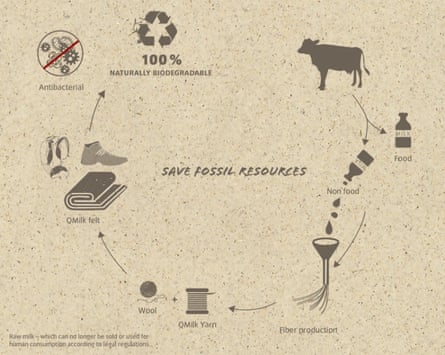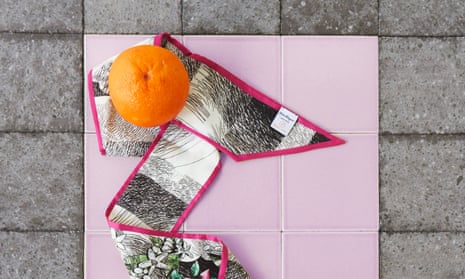Orange peel is the unlikely by-product behind a new textile that’s being incorporated into collections by designer Salvatore Ferragamo.
Back in 2013, Adriana Santanocito, a fashion student in Milan, and her friend and colleague Enrica Arena looked into whether anything useful could be done with the vast amounts of orange peel left behind by juicing machines.
“When you squeeze the orange at an industrial level, half of it is waste that has to be disposed of,” says Arena. “Some companies were sued because they weren’t disposing of the orange waste in the right way and were just dumping it in the fields – and Italy has 700,000 tonnes of orange waste a year.”
Working with the polytechnic university of Milan, the pair developed and patented a process that attracted €500,000 in funding from private investors, the EU and the H&M Foundation. They are now collaborating with Boniser, an orange producer, to turn the peel into a silk-like fabric, Orange Fiber.
“The fashion industry is considered the second biggest polluter in the world,” says Arena. “But we are quickly changing business models in terms of where materials come from and how we produce them, and I can see a lot of pressure on major brands to change.”
The eponymous company behind the material offers the fabric for €30-€40 per metre and it can be coloured and treated on the same production lines as silk. Orange Fiber is just one of a number of small firms experimenting with repurposing everything from waste milk to pineapple stalks to make fibres for clothing and accessories.
“The way clothes are made and used today is massively wasteful,” says Rob Opsomer, systemic initiatives lead at the Ellen MacArthur Foundation, a charity that promotes recycling and reuse. “The equivalent of one garbage truck of textiles is wasted every second, while less than 1% of clothing is recycled into new clothes. Clothes release half a million tonnes of microfibres into the ocean every year. On top of this, if nothing changes, the fashion industry will consume a quarter of the world’s annual carbon budget by 2050.”
Producing a kilogram of cotton currently requires three kilograms of chemicals, according to the Foundation, which believes innovation in materials making, to avoid toxic substances, is crucial. “Also important are innovations that use waste products from other industries as a feedstock, such as Orange Fiber, and artificial silk fibres, such as Biosteel Fiber or Bolt Threads, or fibres produced from algae, such as AlgaeFabrics,” adds Opsomer.
Dairy threads
German company QMilk recently presented its fibre, made from waste cow’s milk, on the runway of Berlin’s Mercedes-Benz Fashion Week, as part of a collection of backpacks and shoes by outdoor clothing company Vaude.
QMilk was started seven years ago after biologist Anke Domaske – who was searching for a non-allergenic fibre for clothes for her stepfather, who was suffering from cancer – stumbled upon YouTube videos of a 1930s technique to create fibre from milk proteins.

“We first succeeded in getting the product stable in 2015, and the first commercial applications were in paper, tissues and toilet paper, because the supply chain is shorter there,” says Domaske. “Now we have the first yarns and fabrics, and the felt can be used for fashion applications also.
“More than 2m tonnes of milk is disposed of every year in Germany alone and, rather than throwing it away, we should make something from it. Our fibre is anti-bacterial, flame-retardant, temperature-regulating and, in special applications, it can also bond fibres together and still be compostable: we want to make other fibres better.”
Vaude’s Benedikt Tröster says his company is constantly searching for new alternatives to synthetic fibres, which are normally based on fossil fuels: “Our goal is to make a shift to renewable and bio-based materials.”
Some people want to revive fibres that have fallen out of fashion, and are now grown as food crops, such as hemp. In Los Angeles, Isaac Nichelson’s company, Circular Systems, wants to create cotton-like fibres from agricultural waste – everything from the acres of stalks left after hemp and flax oil are farmed to tropical pineapple, banana and sugar-cane waste. “We call it the fibre crisis,” he says. “Our whole industry is based on either the synthetics industry – so petrochemicals – or a [genetically modified] cotton monopoly. Both are extremely destructive. Thankfully the industry is finally waking up to this.”
Gwen Cunningham, who leads the circle textiles programme at campaign group Circle Economy, believes small innovators can demonstrate the business case to larger firms – particularly with the help of initiatives linking them such as the denim alliance. “These examples are very much on the radar of the bigger companies,” she says, “and there’s a willingness from government to help if there’s combined action.”
Sign up to the regular Guardian B2B email here for more insight and advice direct to your inbox.

Comments (…)
Sign in or create your Guardian account to join the discussion